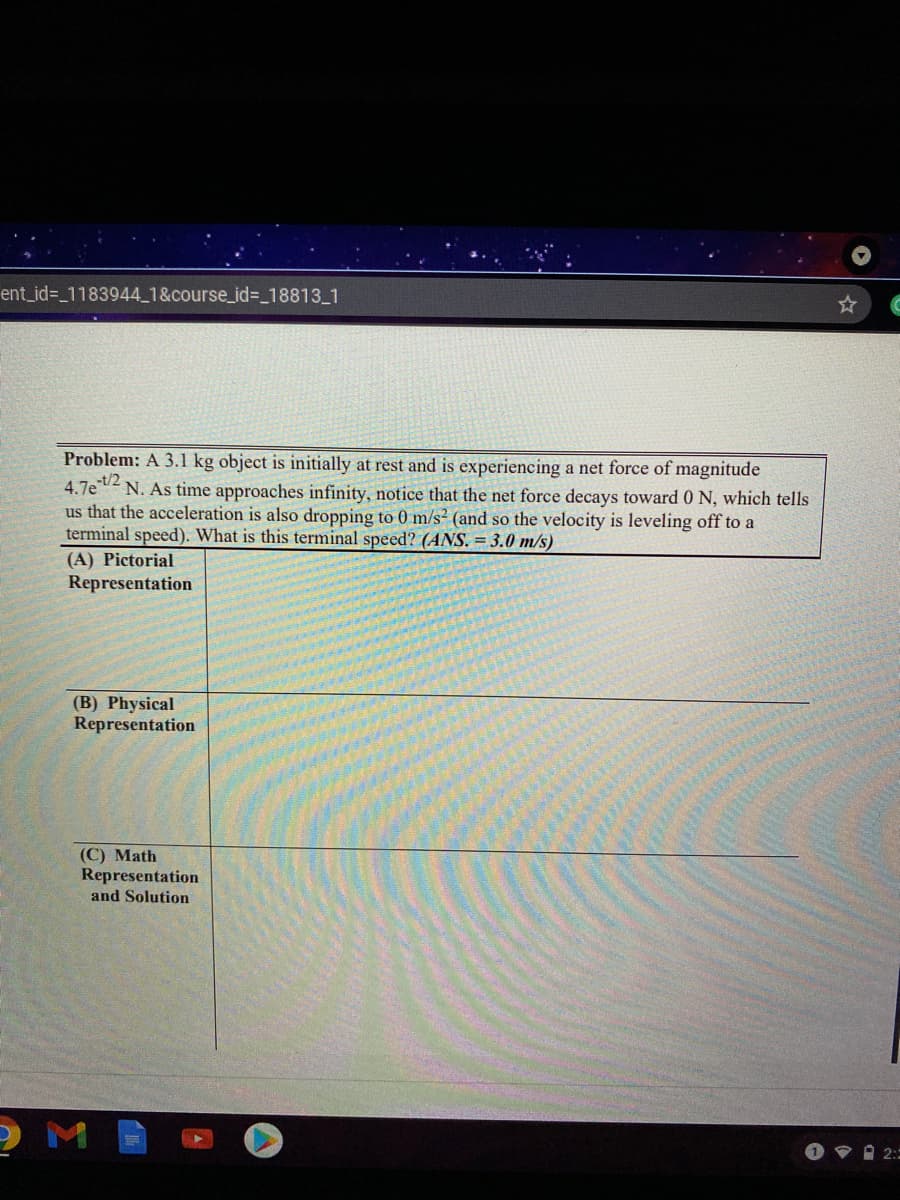A 3.1 kg object is initially at rest and is experiencing a net force of magnitude 4.7e^-t/2 N. As time approaches infinity, notice that the net force decays toward 0 N, which tells us that the acceleration is also dropping to 0 m/s^2 (and so the velocity is leveling off to a terminal speed). What is the terminal speed? (Ans.= 3.0 m/s)
A 3.1 kg object is initially at rest and is experiencing a net force of magnitude 4.7e^-t/2 N. As time approaches infinity, notice that the net force decays toward 0 N, which tells us that the acceleration is also dropping to 0 m/s^2 (and so the velocity is leveling off to a terminal speed). What is the terminal speed? (Ans.= 3.0 m/s)
Elements Of Electromagnetics
7th Edition
ISBN:9780190698614
Author:Sadiku, Matthew N. O.
Publisher:Sadiku, Matthew N. O.
ChapterMA: Math Assessment
Section: Chapter Questions
Problem 1.1MA
Related questions
Question
A 3.1 kg object is initially at rest and is experiencing a net force of magnitude 4.7e^-t/2 N. As time approaches infinity, notice that the net force decays toward 0 N, which tells us that the acceleration is also dropping to 0 m/s^2 (and so the velocity is leveling off to a terminal speed). What is the terminal speed? (Ans.= 3.0 m/s)

Transcribed Image Text:ent_id=_1183944 1&course_id%3D_18813 1
Problem: A 3.1 kg object is initially at rest and is experiencing a net force of magnitude
4.7e N. As time approaches infinity, notice that the net force decays toward 0 N, which tells
us that the acceleration is also dropping to 0 m/s² (and so the velocity is leveling off to a
terminal speed). What is this terminal speed? (ANS. = 3.0 m/s)
(A) Pictorial
Representation
(B) Physical
Representation
(C) Math
Representation
and Solution
2:
Expert Solution
Step 1
Solution:
Let net force acting on the body be dF
Since it is given that,
Now,
since,
Then
, therefore,
Terminal velocity on the mass=3m/s
Step by step
Solved in 2 steps with 1 images

Knowledge Booster
Learn more about
Need a deep-dive on the concept behind this application? Look no further. Learn more about this topic, mechanical-engineering and related others by exploring similar questions and additional content below.Recommended textbooks for you

Elements Of Electromagnetics
Mechanical Engineering
ISBN:
9780190698614
Author:
Sadiku, Matthew N. O.
Publisher:
Oxford University Press

Mechanics of Materials (10th Edition)
Mechanical Engineering
ISBN:
9780134319650
Author:
Russell C. Hibbeler
Publisher:
PEARSON

Thermodynamics: An Engineering Approach
Mechanical Engineering
ISBN:
9781259822674
Author:
Yunus A. Cengel Dr., Michael A. Boles
Publisher:
McGraw-Hill Education

Elements Of Electromagnetics
Mechanical Engineering
ISBN:
9780190698614
Author:
Sadiku, Matthew N. O.
Publisher:
Oxford University Press

Mechanics of Materials (10th Edition)
Mechanical Engineering
ISBN:
9780134319650
Author:
Russell C. Hibbeler
Publisher:
PEARSON

Thermodynamics: An Engineering Approach
Mechanical Engineering
ISBN:
9781259822674
Author:
Yunus A. Cengel Dr., Michael A. Boles
Publisher:
McGraw-Hill Education

Control Systems Engineering
Mechanical Engineering
ISBN:
9781118170519
Author:
Norman S. Nise
Publisher:
WILEY

Mechanics of Materials (MindTap Course List)
Mechanical Engineering
ISBN:
9781337093347
Author:
Barry J. Goodno, James M. Gere
Publisher:
Cengage Learning

Engineering Mechanics: Statics
Mechanical Engineering
ISBN:
9781118807330
Author:
James L. Meriam, L. G. Kraige, J. N. Bolton
Publisher:
WILEY